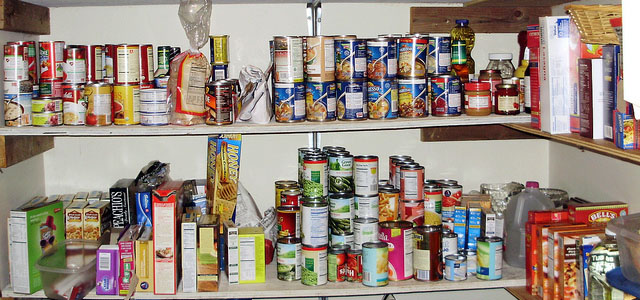What types of Long Term Food Should You Store?
One goal is creating a “food under disaster” plan is deciding what it is we want to store. This can be tough to figure out even with input from family members. So we created a generic food cache inventory list for our users. The image attached below is a blank sample of what a generic food cache list might mimic. Feel free to use ours. A blank worksheet (as well as a full set of recommendations) is downloadable here. Once you have a copy of the food cache template fill it up with the foods your family both can get the most out of while still trying to keep comfort in mind. I would also go so far as highlighting foods by destination as well be it freezer, refrigerator or pantry.
 Have the food cache inventory list near your cache and accessible. As items are used and consumed change the current stock and quantity needed to show what items need to be restocked. On your next trip to the grocery store don’t forget to bring your inventory sheet. As long as you rotate evenly you can have a larger store of foods without a need for an over extended shelf life. You can really change things up and broaden your horizon. I know its nice to have a large store of bland, easy to store food and there are important reason for doing so, such as extended shelf life and calorie intake. But lets not forget the morale of the people eating it.
Have the food cache inventory list near your cache and accessible. As items are used and consumed change the current stock and quantity needed to show what items need to be restocked. On your next trip to the grocery store don’t forget to bring your inventory sheet. As long as you rotate evenly you can have a larger store of foods without a need for an over extended shelf life. You can really change things up and broaden your horizon. I know its nice to have a large store of bland, easy to store food and there are important reason for doing so, such as extended shelf life and calorie intake. But lets not forget the morale of the people eating it.
Diversifying your food storage options enables you to also store a large assortment of commercially available food. Just remember to rotate the stock that does not have a prolonged shelf life. Doing this also frees you from restriction. You can now incorporate taste into the equation. No more freeze dried bananas and oats! Not that we are opposed to freeze dried food such as bananas and oats. Stock it up. But mix it up as well. There is no reason not to so long as you rotate.
So you are looking to stock up your food cache? No need to go to a military surplus every time. Those stores serve a great purpose but you don’t need to look past your local grocer most of the time. Storing food with long shelf life no longer means you are restricted to MRE’s. That being Meals Ready To Eat. If you ever served in the military or know someone who has you know that MRE’s can be fun for a day or two but relying on them for 3 meals a day can grow tiresome in a hurry.
Keep it simple and keep it basic. That is the motto many preppers share and also a way of thinking that you should try and follow. With that motto comes Gardening & Canning your own food. There are many books on that which over those topics in great deal. While we cover the basic introduction to this topic further on, greater detail can be found elsewhere. Keep in mind that these activities while excellent and recommended are not necessary to create a well rounded food cache.
The new USDA food pyramid should be consulted when deciding what types of food to store. Information we take for granted is often overlooked. You may be against food pyramid recommendations for whatever reason (as some families may be) however it has been recently updated and provides thoroughly researched data in regard to proper nutrition.
You may think that creating a survival cache consist of buying large quantities in bulk but that is not always the case. After your base food cache is in place eat from your stores regularly. This not only insures stock rotation (putting newest food to the rear) but your family will thank you for it if ever they must rely on the cache. It would be filled with foods they know and like.
All boxed and canned foods will remain fresh a minimum of thirty days after purchase. Raw meats and breads however must remain frozen to ensure the “30 day fresh” mark. Most dairy products such as cheese, butter and yogurts have a modest refrigerator life where as hard cheese and shelf milk don’t require refrigeration at all. Shelf stable milk makes an excellent alternative in a disaster scenario as it is created using a high temperature pasteurization granting it a shelf life of many many months. For an even longer storage powdered milk products become even better backup alternatives. Several manufacturers offer shelf stable and powdered milk and it is readily available.
When stocking up on frozen or refrigerated foods please keep in mind the possibility of electricity loss. If you do not have a proper way to backup your electricity there are a few neat tricks to keep your food cool for a few days.
- Try not to keep your fridge door ajar any longer than you have to
- Have your fridge / freezer packed with as little empty space as possible
- Place blocks of dry ice in your refrigerator
In the event that you have excess amount of frozen food thawing have one blow out of a BBQ and invite your friends and family over. Even if you dislike your neighbors creating a mini-network during tough times can be the difference between tough times and a full blown family disaster, so invite your neighbors as well.
The Revised Food Pyramid
Your family has a preference in food no doubt. This you already know. You may not know how to pull off a balanced nutrient rich food storage plan however. The Food Pyramid, ages old is more useful now than ever before. This may feel like a refresher course in nutrition 101 but a vital part of prepping is stocking your food stores with the right type of food.
In 2005 an updated Food Pyramid chart was released by the (USDA) United States Department of Agriculture. It breaks down and highlights 5 basic food groups as well as fats & oils.
Grains
Grain products are the very foundation of the food pyramid and consist of pastas, breads, cereal, oatmeal, rice etcetera. The food pyramid recommendation is that half of your grains be whole grains. Whole grain foods offer more fiber and vitamins as they are made with the entire grain kernel. With that said they also have been proven to lower the risk of several diseases. Once the grain is refined and processed the bran and germ are stripped. The only upside to processing is an extended shelf life. Stripping the bran / germ also removed a lot of the B vitamins and fiber. With that being said whole grain foods are healthier and also higher in fiber. This also helps you regulate your digestive track and also feel full for a longer period of time.
One can also store raw wheat to grind but in order to do so a grain mill (manual or electric) is required. When dealing with extremely large stockpiles of raw wheat a grain mill will become a required item as raw wheat will last much longer than ground wheat.
Do you also plan on baking your own foods? If so do not forget to store baking items such as baking powder, baking soda, cornstarch, sugar, salt, yeast and more. We should remember that home baked foods are generally known to be healthier options because they contain fewer preservatives. Also add flavorings and spices to your store such as chili powder, cocoa, cinnamon and vanilla. It would not hurt to have a few good all purpose cookbooks at your disposal as well. Know how to use what you store.
Fruits & Vegetables
You may have heard this before: we don’t get enough fruits and vegetables. Some may not like the taste or even texture. Others may find alternate excuses for not consuming enough fresh vegetables or fruits. The end result however is that better health can be gained from eating fresh produce and that we should make more of an effort to include these in our diets. So “less sweets & meats and more fruits and veggies” is a motto everyone could stand to follow a little closer.
There are many different ways in which we can obtain our recommended servings of fruits and vegetables be it in juice, cooked, canned, frozen, dried or fresh. Dietary nutritionist and other health care experts agree that eating a wide assortment of fruits and vegetables of different colors and textures is important to our health as each food has a unique property that promotes a different aspect of good health. When preparing for the food aspect of your personal disaster plan please take 2 actions:
Have a more balanced diet – Try some of the whole grain products on the market and eat more fruits and vegetables. Switching from more sweets to more fruits and vegetables should help you to lose any extra pounds, instantly improving your general health and overall level of physical activeness. In any disaster scenario a good physical fitness level is useful to overcome any challenges you may face such as extended periods of walking or hiking, chopping wood and repairing various aspects of your home.
Eat new foods – Stop passing up on those fruits and veggies in the grocery store, eat them! You may broaden your taste bud horizon and better your health at the same time. Having a more balanced appetite and wider taste for a variety of fresh food can be very useful if you ever face a shortage.
Dairy
Two words. Low fat. The new Food Pyramid means low fat dairy products. Not only are they much lower in saturated fat but also calories. Professionals say a diet with low levels of saturated fat intake ties into lower cholesterol rates.
Your dairy products consist of cheese, milk, pudding, yogurt and ice cream. For our readers who are lactose intolerant there are many lactose free dairy products.
Proteins
Meat, fish, poultry, egg, nuts, beans and even seeds. Protein sources are included of all of these foods and more. Even better the Food Pyramid suggests eating lean meats, poultry and fish with the skin removed. Most meats that are processed usually contain extra amounts of sodium. Processed meats also contain other ingredients that may compromise positive health factors when consuming food with proteins.
As mentioned earlier beans and peas can contain adequate levels of protein. Eggs also contain very high levels of protein. Keep in mind that with high levels of various protein come with high levels of cholesterol. If you eat eggs often a healthier option might be to opt out of the yoke and eat only the egg whites.
Lastly we have nuts and seeds. Health experts in the medical community have found through studies that eating 1 ½ ozs of nuts each day can reduce the risk of heart disease. With this also comes a high calorie count that goes a long way. 1oz = only ¼ a cup.
Fats, Oils & Sweets
Fat is everywhere. Mayonnaise to butter. Animal fat to candy bars or cooking oil, you probably have no trouble getting enough fat in your diet. Oils are probably even worse as they are basically just fats in liquid form at room temperature. Most of these oils are low in saturated fats and have little to no cholesterol. A few rare exceptions are palm kernel oil and coconut oil which are very high in saturated fat. Something to note and stay away from when possible. There are several cooking oils including olive oil, canola oil, corn oil,soybean oil and more.
Then we have solid fats. Solid fats are self explanatory, being solid fat at room temperature Solid fat come from many animal products such as beef fat and pork fat. They makeup food items such as butter and margarine and vegetable shortening. Solid fats can also be made from vegetable oils through what is known as hydrogenation. The (AHA) American heart Association recommends that if you consume fats and oils to have them contain less than 2 grams of saturated fat per tablespoon, such as olive oil or canola. It is also recommended by the AHA that you limit your dietary fat to 30% of your total daily calorie intake. This is very hard to do given many foods such as peanut butter, whole milk and even steak get a lot of its calories from fat. With that said there is no reason to wonder why so many Americans often exceed that 30% calorie from fat recommendation. On the other end of the spectrum it would be hard to think of a scenario where a lower dietary fat intake would be a health concern. You would do well to avoid fats, oils and sweets when possible.
Sweets & sweeteners also fall into a similar category with the same concept. Still I think I would want to stock things such as sugar, homemade maple syrup, brown sugar and other artificial sweeteners for your families favorite treats and fresh baked goods. In the midst of tough time simple things like a child’s favorite snack can be a real difference maker and cause for a smile.
Food Summary
If you take anything away from what you have read so far I hope it would be the importance of introducing your family to a well balanced and healthy diet if you haven’t already done so. The new and improved Food Pyramid can help you and your family create a eating plan that is both healthy and fun to follow. When it comes to your food store have it extend to the bare minimum of a thirty day supply. There is nothing wrong with having a separate cache of survival food such as freeze dried products with shelf lives of 25 years or more but a better rule of thumb to live by is to store what you eat and eat what you store. As long as you rotate your food properly you can easily manage a massive stockpile of food. By all means this is the most practical approach for any family facing tough times or practicing good preparation standards.
Cover image via Flikr
 Survive Our Collapse Building Self-Reliance in an Uncertain World
Survive Our Collapse Building Self-Reliance in an Uncertain World





Media: https://l.facebook.com/l.php?u=https%3A%2F%2Fmedia1.tenor.co%2Fm%2FMG1RS6oiHeEAAAAC%2Fwe-removed-this-post-because-it-looked-like-spam.gif&h=AT1ne-vw-w-TxFhw-trH6JyQF9x3CmdnKm7YIljx4gAM0xAuTcnM2rG7ePR-2TdvWoreZLUwU7Dex_2LIRPuvV3PNyc_IIeD_tOMSzfqCJ9aNI3Hk6B8W08AOSP51i8LPWyMt2jQgECCTImv&s=1
Spam last forever. Chill just a bit dude